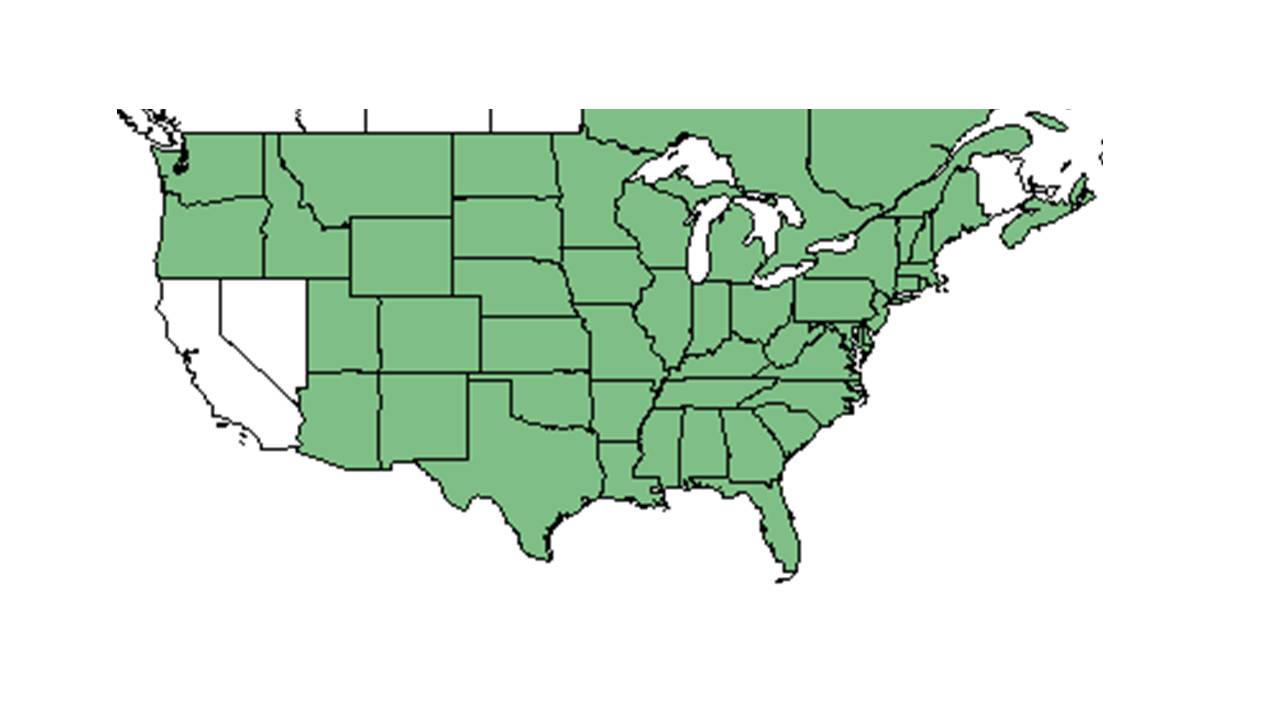Difference between revisions of "Physalis heterophylla"
(→Taxonomic notes) |
(→Distribution) |
||
| Line 30: | Line 30: | ||
==Distribution== | ==Distribution== | ||
| − | ''P. heterophylla'' is widespread in the eastern and central United States, north to adjacent Canada, and south to northeastern and Panhandle Florida.<ref name= | + | ''P. heterophylla'' is widespread in the eastern and central United States, north to adjacent Canada, and south to northeastern and Panhandle Florida.<ref name=weakley/> |
==Ecology== | ==Ecology== | ||
Latest revision as of 15:12, 19 June 2023
| Physalis heterophylla | |
|---|---|

| |
| Photo by Ohio State Weed Lab, The Ohio State University, Bugwood.org | |
| Scientific classification | |
| Kingdom: | Plantae |
| Division: | Magnoliophyta - Flowering plants |
| Class: | Magnoliopsida – Dicotyledons |
| Order: | Solanales |
| Family: | Solanaceae |
| Genus: | Physalis |
| Species: | P. heterophylla |
| Binomial name | |
| Physalis heterophylla Nees | |

| |
| Natural range of Physalis heterophylla from USDA NRCS Plants Database. | |
Common name: clammy ground-cherry, ground cherry, husk tomato
Contents
Taxonomic notes
Synonyms: none[1]
Varieties: Physalis ambigua (A. Gray) Britton; P. heterophylla Nees; P. heterophylla var. ambigua (A. Gray) Rydberg; P. heterophylla var. clavipes Fernald; P. heterophylla var. heterophylla; P. heterophylla var. nyctaginea (Dunal) Rydberg; P. nyctaginea Dunal[1]
Description
"Annual or perennial, glabrous or pubescent herbs. Leaves petiolate, entire to coarsely dentate, the base tapered, subcordate or oblique. Flower axillary, solitary; the calyx tube expanding, papery and bluntly conical when mature, loosely enclosing the fruit. Corolla campanulate to subrotate, yellow, often with 5 dark spots in the base of the tube; stamens 5, erect, separate, anther yellow or blue, dehiscing by lateral slits berry somewhat mealy, 2-locular, globose."[2]
"Rhizomatous, often viscid perennial 2-9 dm tall. Stem pubescence of glandular trichomes mixed with both long and short nonglandular trichomes. Leaves widely ovate or oblanceolate to triangular or lanceolate, 3-11 cm long, 3-8 cm wide, sinuate-dentate or coarsely and irregularly dentate, rarely subentire, weakly cordate. Calyx 7-12 mm long, lobes triangular to lanceolate, shorter than the tube; corolla 10-18 mm long or broad, with 5 brownish basal spots; anthers yellow or rarely bluish, 3.5-4.5 mm long. Berry ca. 10 mm in diam., the fruiting calyx 2.5-3 cm long, about as broad."[2]
Distribution
P. heterophylla is widespread in the eastern and central United States, north to adjacent Canada, and south to northeastern and Panhandle Florida.[1]
Ecology
Habitat
P. heterophylla has been documented to grow in calcareous coastal hardwood hammocks, drying sand bordering woods, upland sandhills and annually burned longleaf pineland.[3] It has also been observed growing in old biocontrol plots and a fallow quail food patch. It has been documented in moist sandy loam and in the loam soils of the Red Hills Region.[3] Associated species include longleaf pine.[3]
P. heterophylla has shown regrowth in reestablished longleaf woodlands that were disturbed by agriculture in South Carolina, making it an indicator species for post-agricultural woodlands.[4]
Phenology
P. heterophylla flowers from May through September and fruits from July through September.[3][5]
Seed dispersal
This species is thought to be dispersed by consumption by vertebrates.[6]
Fire ecology
Populations of Physalis heterophylla have been known to persist through repeated annual burns.[7][8]
Pollination
Physalis heterophylla has been observed to host sweat bees such as Lasioglossum pectinatum (family Halictidae), plant bugs such as Reuteroscopus ornatus (family Miridae), ground nesting bees such as Perdita halictoides (family Andrenidae), and plasterer bees from the Colletidae family such as Colletes latitarsis and C. willistoni.[9]
Conservation, cultivation, and restoration
Cultural use
The fruit can be used as a substitute for tomatoes.[10]
Photo Gallery
References and notes
- ↑ 1.0 1.1 1.2 Weakley, A.S. 2020. Flora of the Southeastern United States. Edition of 20 October 2020. University of North Carolina at Chapel Hill, Chapel Hill, North Carolina.
- ↑ 2.0 2.1 Radford, Albert E., Harry E. Ahles, and C. Ritchie Bell. Manual of the Vascular Flora of the Carolinas. 1964, 1968. The University of North Carolina Press. 927. Print.
- ↑ 3.0 3.1 3.2 3.3 Florida State University Robert K. Godfrey Herbarium database. URL: http://herbarium.bio.fsu.edu. Last accessed: July 2015. Collectors: Loran C. Anderson, Andre F. Clewell, R. F. Doren, R. Komarek, J. M. Kane, Lisa Keppner. States and Counties:Florida: Calhoun, Leon, Nassau, Wakulla, Washington. Georgia: Thomas. Compiled by Tall Timbers Research Station and Land Conservancy.
- ↑ Brudvig, L.A., E Grman, C.W. Habeck, and J.A. Ledvina. (2013). Strong legacy of agricultural land use on soils and understory plant communities in longleaf pine woodlands. Forest Ecology and Management 310: 944-955.
- ↑ Nelson, G. PanFlora: Plant data for the eastern United States with emphasis on the Southeastern Coastal Plains, Florida, and the Florida Panhandle. www.gilnelson.com/PanFlora/ Accessed: 12 DEC 2016
- ↑ Kirkman, L. Katherine. Unpublished database of seed dispersal mode of plants found in Coastal Plain longleaf pine-grasslands of the Jones Ecological Research Center, Georgia.
- ↑ Robertson, K.M. Unpublished data collected from Pebble Hill Fire Plots, Pebble Hill Plantation, Thomasville, Georgia.
- ↑ Platt, W.J., R. Carter, G. Nelson, W. Baker, S. Hermann, J. Kane, L. Anderson, M. Smith, K. Robertson. 2021. Unpublished species list of Wade Tract old-growth longleaf pine savanna, Thomasville, Georgia.
- ↑ Discoverlife.org [1]
- ↑ Fernald, et al. 1958. Edible Plants of Eastern North America. Harper and Row Publishers, New York.